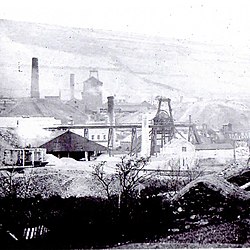
Laxey is a village on the east coast of the Isle of Man. Its name derives from the Old Norse Laxa meaning 'Salmon River'. Its key distinguishing features are its three working vintage railways and the largest working waterwheel in the world. It is also the location of King Orry's Grave.

Ramsey is a coastal town in the north of the Isle of Man. It is the second largest town on the island after Douglas. Its population is 7,845 according to the 2016 census. It has one of the biggest harbours on the island, and has a prominent derelict pier, called the Queen's Pier. It was formerly one of the main points of communication with Scotland. Ramsey has also been a route for several invasions by the Vikings and Scots.

The Manx Electric Railway is an electric interurban tramway connecting Douglas, Laxey and Ramsey in the Isle of Man. It connects with the Douglas Bay Horse Tramway at its southern terminus at Derby Castle at the northern end of the promenade in Douglas, and with the Snaefell Mountain Railway at Laxey. The line is undulating and passes through areas of scenic beauty. Many visitors take an excursion on the trams.

Foxdale is a small village in the heart of the Isle of Man. The village falls within the sheading of Glenfaba. Politically it is part of the constituency of Glenfaba & Peel and is currently represented in Tynwald and the House of Keys by Ray Harmer MHK and Geoffrey Boot MHK. The village is served by Patrick Parish Commissioners. The village has a heritage centre which is run voluntarily.

John Allen Mylrea MHK, was a member of the House of Keys, Chairman of the Isle of Man Steam Packet Company and a director of Dumbell's Bank, who in the late 19th century played a prominent part in the arts and culture of the Isle of Man.

The Manx Northern Railway (MNR) was the second common carrier railway built in the Isle of Man. It operated as an independent concern only from 1879 to 1905.

Creg-ny-Baa, Isle of Man (, is located between the 3rd Milestone and 4th Milestone of the primary A18 Snaefell Mountain Road and the road junction with the secondary B12 'Creg-ny-Baa Back-Road', in the parish of Kirk Onchan in the Isle of Man.
The Foxdale Railway was a 3 ft narrow gauge branch line which ran from St. John's to Foxdale on the Isle of Man.

The Great Snaefell Mine, also referred to as the East Snaefell Mine, was a zinc mine located high in the Laxey Valley on the slopes of Snaefell Mountain, in the parish of Lonan, Isle of Man. The mine reached a depth of 1,188 ft (362 m) and is remembered as the scene of the Isle of Man's worst mining disaster in 1897.
The Great Snaefell Mining Company was a mining company formed to operate the Great Snaefell Mine on the Isle of Man.

The Great Laxey Mine was a silver, lead ore and zinc mine located in Laxey, in the parish of Lonan, Isle of Man. The mine reached a depth in excess of 2,200 ft (670.6 m) and consisted primarily of three shafts; the Welsh Shaft, the Dumbell's Shaft and the Engine Shaft each of these shafts being connected by a series of levels.
The Isle of Man Mining Company, also referred to as the Foxdale Mining Company, was a mining company formed to operate the Foxdale Mines on the Isle of Man.

The Ballajora Mine also referred to as the Maughold Head Mine, was an iron ore, hematite and copper mine located in the parish of Maughold, Isle of Man. The mine lay principally on the farmland of Magher-beck. The head engineer of the mine, referred to as the Mine Captain, was John Faragher.

The Maughold Head Mine was a copper mine located in the parish of Maughold, Isle of Man.
The Maughold Head Mining Company was a mining company formed to explorate around the area of Maughold Head on the Isle of Man. The company's registered offices were at 30, John St, Bedford Row, London.

The Dhyrnane Mine was a hematite and iron ore mine located in the parish of Maughold, Isle of Man.

William Henry Kitto was Captain of the Foxdale Mines, vice-chairman of the Isle of Man Steam Packet Company, a director of the Isle of Man Railway and a Justice of the Peace who became a Member of the House of Keys for the constituency of Glenfaba in 1902.

Dumbell's Bank was a bank in the Isle of Man. The bank's insolvency in 1900, known as Black Saturday and referred to in the Isle of Man as the Dumbell's Bank Crash, resulted in a run on the bank with many individuals losing their life savings and the ruin of numerous local businesses causing poverty, depression and bankruptcy. The effects were profound and lasted for a considerable number of years.

John Kewley was Captain of the Great Snaefell Mine, Isle of Man. He is remembered for his heroism following the Snaefell Mine Disaster of 1897, during which he displayed extraordinary courage and endurance and for which he received the Medal of the Honourable Order of the Knights of St John of Jerusalem.
The geology of the Isle of Man consists primarily of a thick pile of sedimentary rocks dating from the Ordovician period, together with smaller areas of later sedimentary and extrusive igneous strata. The older strata was folded and faulted during the Caledonian and Acadian orogenies The bedrock is overlain by a range of glacial and post-glacial deposits. Igneous intrusions in the form of dykes and plutons are common, some associated with mineralisation which spawned a minor metal mining industry.














